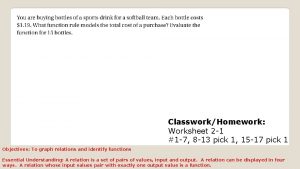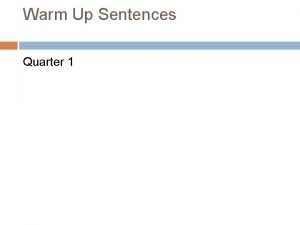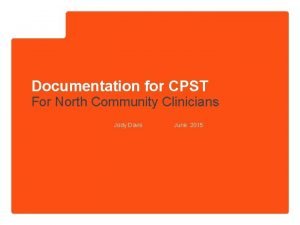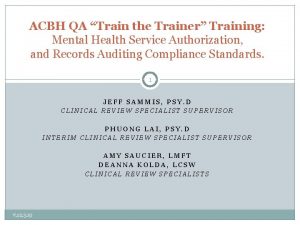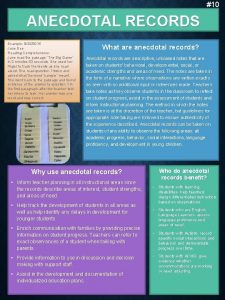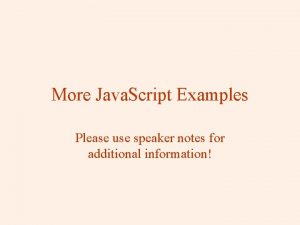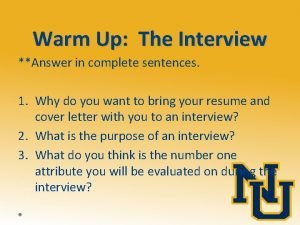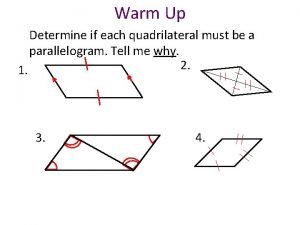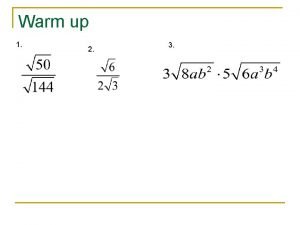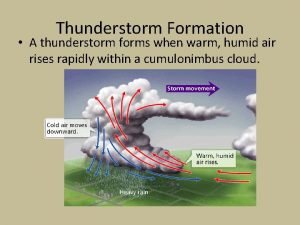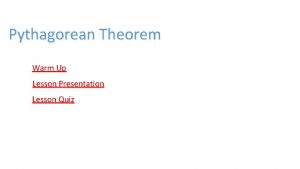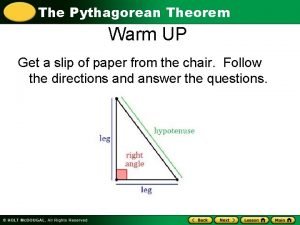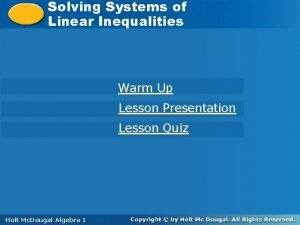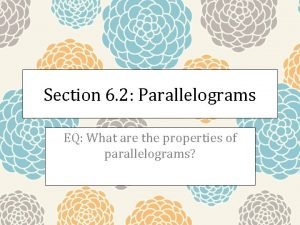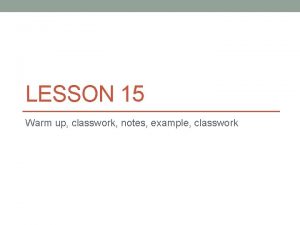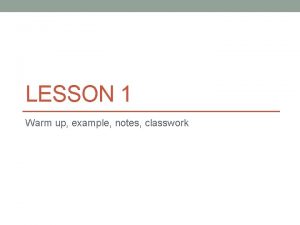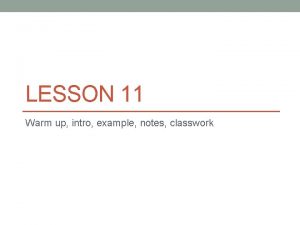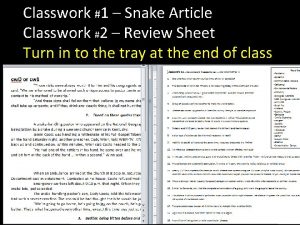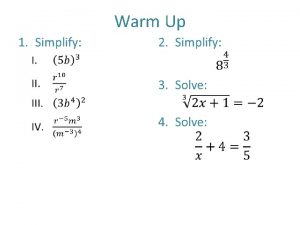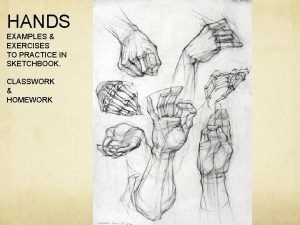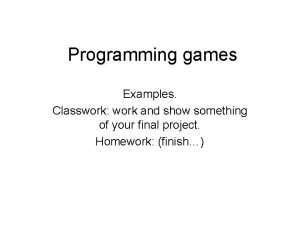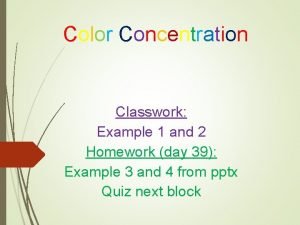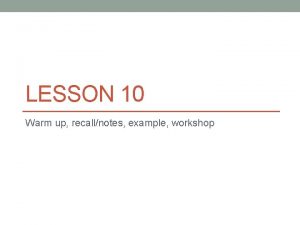LESSON 1 warm up example classwork notes examples















































































- Slides: 79

LESSON 1 warm up, example, classwork, notes, examples, classwork, notes, example, notes, classwork

Warm Up

Example 1 •

Example 2 KEY POINT: When factoring a polynomial, you want to first look for the monomial that is the Greatest Common Factor of all terms in the polynomial. Then you do the reverse of distributive property.

Classwork part 1 • Complete classwork problems #1 -3

Notes, pt. 1 • Factoring and distributing are opposite processes. • The result of the distributive property is expanded form; the result of factoring is factored form. • Distributing is sometimes called expanding. • By factoring out the GCF, you leave a prime polynomial that is considered factored completely.

Example 3 – Multiplying 2 Binomials •

Example 4 – Difference of Squares Notes, pt. 2 •

Classwork part 2 • Complete classwork problem #4 -7

Example 5 – Square of a Binomial Notes, pt. 3 •

Classwork, pt. 3 Must Do May Do • Classwork 1 #1 - 9 • Khan Academy • Reflection questions • Carnival Bears/Crossing the River • Exponents review • Linear equation practice • Slope practice • HW 1 #4

LESSON 2 Warm Up, notes, classwork, notes, example, classwork

Warm Up • Are there like terms that can be combined? What is the simplest product?

Notes, part 1

Classwork part 1 • Complete classwork problems #1 -2

Notes, part 2

Example 1 •

Classwork part 2 • Complete classwork problems #3

Notes, part 3 When the leading coefficient of a quadratic expression isn’t 1, the first step in factoring should be see if all the terms in the expanded form have a common factor. After factoring out the GCF, it may be possible to factor again.

Example 2

Workshop Must Do May Do • Classwork 2 #1 -3 • Complete cw #1 • Summary/Reflection • Khan Academy • Crossing River/Carnival Bears • Linear Equation practice • Exponents • Slope practice

LESSON 3 Warm up/example, more examples, classwork

Warm Up/example 1 •

Example 1, continued •

Example 1, continued •

Warm Up/example 1 • Can you verify that our algebra is correct using a diagram or visual display? Try: What if the square was 4 x 4, and you changed to the rectangle? 7 x 7?

Example 2 • 1 x 15, 3 x 5 (why can I ignore the negative options? ) 2(1)+15 or 1+2(15) or 2(3)+5 or 3+2(5)

Example 2, continued •

Example 3 •

Classwork Must Do May Do • Exit ticket 1 -2 • Khan Academy • Classwork 3 #1 -10 • Challenge questions MUST be attempted • Exponents review • Reflection/summary question • Linear practice • Slope practice

LESSON 4 Long example, classwork

Warm Up •

Example • Step 1: Multiply (a) and (c) Step 1: 6(-6) = -36 Step 2: Find factor pairs that make the answer from step 1 Step 2: (4, -9) (-4, 9) (-6, 6) (2, -18) Step 3: Choose pair that adds to (b) Step 3: 9 and -4 Step 4: Rewrite expression with split middle term. Step 5: Split the 4 -term expression into two parts. Step 6: Use an area model or factor by grouping. (-2, 18) (1, -36) (-1, 36) (3, -12) (-3, 12)

Example, continued • Step 6: Use an area model or factor by grouping. Factor out the common factor from each group. Factor out the common factor.

Workshop Must Do May Do • Classwork 3 #1 -10 • Khan Academy • Classwork 4 #1 -5 • Summary/reflection included • Exponents review • Linear practice • Slope practice

LESSON 5 Warm up, notes, examples, classwork

Warm Up •

Notes

Example 1 (long-ish)

Example 1, continued d. To make this easier, rewrite the original expanded form equation so that it is equal to zero and solve. e. What are the actual dimensions of the rectangle (in context)?

Example 2

Classwork Must Do May Do • Exit ticket 4 • Khan. Academy • Classwork 5 #1 -7 • Crossing the River/Carnival Bears • Exponents review • Linear practice • Slope practice • Start homework 5

LESSON 6 Warm up, examples(2), brief notes, classwork

Warm Up •

Example 1 • • In context, which answer actually makes sense?

Notes •

Example 2 •

Example 2, continued •

Workshop Must Do May Do • Classwork 6 #1 -6 • Khan. Academy • Summary/reflection • Finish classwork 5 questions • Linear equation practice • Exponents review • Slope practice • Vocabulary section

LESSON 7 Warm up, examples(2), classwork

Review/Practice •

Warm Up •

Example 1 •

Example 2 •

Workshop Must Do May Do • Exit ticket 5 -6 • Khan. Academy • Classwork 7 #1 -5 • Finish classwork 5 -6 • Summary/reflection • Classwork 7 #6 -7 questions • Linear equation practice • Exponents review • Slope practice • Vocabulary section

LESSON 8 Lengthy notes, example, classwork

Warm Up •

Notes – parts of a quadratic graph •

Notes – parts of a quadratic graph •


Example – don’t write Below are some examples of curves found in architecture around the world. Some of these might be represented by graphs of quadratic functions. What are the key features these curves have in common with a graph of a quadratic function? • Describe the overall shape of a graph of a quadratic function. • What is similar or different about the overall shape of the above curves?

Workshop Must Do May Do • Classwork 8 #1 -4 • Khan. Academy • Summary/reflection • Linear equation practice questions • Exponents review • Slope practice • Vocabulary section • Notes sheet • Folder organize • Complete all cw/hw 1 -8

LESSON 9 Warm up, notes, examples(3), classwork

Warm Up •

Notes •

Example 1 •

Example 1 Points: (0, -40) (4, 0) (-10, 0) (-3, -49) (-6, 40)

Example 2 •

Example 3 •

Example 3, continued •

Workshop Must Do May Do • Classwork 9 #1 -4 • Khan. Academy • Summary/reflection • Linear equation practice questions • Exponents review • Slope practice • Vocabulary section • Notes sheet • Folder organize • Complete all cw/hw 1 -10

LESSON 10 Examples(2), short notes, classwork

Height of the dolphin in feet (distance from water surface) Example 1 • Time in seconds

• Height of the dolphin in feet (distance from water surface) Example 1 Time in seconds

Example 2 •

Example 2 •

Notes (not on mid-unit test) In the table of a quadratic function, the second differences are constant. The creates a predictable pattern of change in the table. (Linear equations have constant first differences – the slope or rate of change).

Workshop Must Do May Do • Exit ticket 7 -9? • Khan. Academy • Classwork 10 #1 -2 • Linear equation practice • Exponents review • Slope practice • Vocabulary section • Notes sheet • Folder organize • Complete all cw/hw 1 -10

Test Content • Factoring. Solving, Word problems, Graphing 1 ab) Area/perimeter of rectangle 1 c) Solve quadratic 1 d) Factor/Solve quadratic 2 a) Factor quadratic 2 b) Distribute 2 c) Combine like terms AND distribute 3) Falling object problem: relate equation to graph, max/min, hit ground, increasing/decreasing, meaning of a point in context, domain, graph it with all key features identified ALSO A REVIEW SECTION – MODULES 1 -3
 Science classwork
Science classwork Classwork/homework linear functions answer key
Classwork/homework linear functions answer key Welcome to google classroom
Welcome to google classroom Geometry unit 1 lesson 1 points lines and planes
Geometry unit 1 lesson 1 points lines and planes Is classwork one word
Is classwork one word Wisc
Wisc Ucapan salam hangat
Ucapan salam hangat Mayflower compact in a sentence
Mayflower compact in a sentence Warm and cool feedback examples
Warm and cool feedback examples Dap note example
Dap note example Descriptive notes example
Descriptive notes example Cornell notes example
Cornell notes example What is reflective note
What is reflective note Concept note sample for project
Concept note sample for project Concept notes example
Concept notes example Cornell notes rubric
Cornell notes rubric Lesson outline lesson 3 describing circuits answers
Lesson outline lesson 3 describing circuits answers Lesson outline lesson 3 mountain building answers
Lesson outline lesson 3 mountain building answers Lesson outline lesson 2 aquatic ecosystems answer key
Lesson outline lesson 2 aquatic ecosystems answer key Macro teaching meaning
Macro teaching meaning L101 introduction to healthcare leadership
L101 introduction to healthcare leadership Theme of a gift of chappals
Theme of a gift of chappals Chapter 1 lesson 1 your total health lesson 1 quiz answers
Chapter 1 lesson 1 your total health lesson 1 quiz answers Weather forecast lesson 3 outline answers
Weather forecast lesson 3 outline answers Sat vocabulary lesson 4
Sat vocabulary lesson 4 Lesson outline physical properties lesson 2
Lesson outline physical properties lesson 2 The science duo physical and chemical changes
The science duo physical and chemical changes Lesson outline lesson 1 climates of earth answers key
Lesson outline lesson 1 climates of earth answers key Lesson outline lesson 1
Lesson outline lesson 1 Lesson outline lesson 1: understanding science answer key
Lesson outline lesson 1: understanding science answer key Today lesson or today's lesson
Today lesson or today's lesson Lesson outline lesson 1 land biomes answers
Lesson outline lesson 1 land biomes answers Lesson 4 gravity and motion lesson review
Lesson 4 gravity and motion lesson review Lesson 2 muscle storyboard
Lesson 2 muscle storyboard Wave properties lesson 2
Wave properties lesson 2 Today's lesson or today lesson
Today's lesson or today lesson 1 important lesson that is worth sharing about this lesson
1 important lesson that is worth sharing about this lesson Today's lesson or today lesson
Today's lesson or today lesson Scrap heap magnet diagram
Scrap heap magnet diagram Lesson outline lesson 3 eclipses and tides answer key
Lesson outline lesson 3 eclipses and tides answer key Anecdotal records in nursing examples
Anecdotal records in nursing examples Case manager notes examples
Case manager notes examples Behavior technician rbt session notes examples
Behavior technician rbt session notes examples Progress notes examples
Progress notes examples Cpst progress notes examples
Cpst progress notes examples Source-oriented charting
Source-oriented charting Birp note example
Birp note example Sample anecdotal records for behavior
Sample anecdotal records for behavior Speaker notes examples
Speaker notes examples Warm front symbol
Warm front symbol Blue water cycle
Blue water cycle 6 panel comic strip
6 panel comic strip Context clues warm up
Context clues warm up Dangling misplaced modifiers
Dangling misplaced modifiers Character trait adjectives
Character trait adjectives Trivia warm up
Trivia warm up As a warm-up here's a question that won't affect your score
As a warm-up here's a question that won't affect your score Advantages and disadvantages of warm up
Advantages and disadvantages of warm up Pyramid warmup
Pyramid warmup State whether each quadrilateral is a parallelogram
State whether each quadrilateral is a parallelogram Brainstorm warm up
Brainstorm warm up Warm up questions and answers
Warm up questions and answers Warm up questions for high school
Warm up questions for high school Pythagorean theorem warm up
Pythagorean theorem warm up Warm lines
Warm lines Epley manuveur
Epley manuveur Romberg rest
Romberg rest Warm front simple definition
Warm front simple definition Thunderstorms form when warm humid air rises in a(n)
Thunderstorms form when warm humid air rises in a(n) Thermoneutral environment for neonates
Thermoneutral environment for neonates Pythagorean theorem warm up
Pythagorean theorem warm up Pythagorean theorem warm up
Pythagorean theorem warm up Warm chain
Warm chain Ispathwarm
Ispathwarm Inequalities warm up
Inequalities warm up 2 parallelograms
2 parallelograms Present perfect auxiliary
Present perfect auxiliary Decomposer
Decomposer How to multiply mixed fractions
How to multiply mixed fractions Warm up activities for teachers workshop
Warm up activities for teachers workshop

